Review: Nokia 5800 XpressMusic - An Alternative Review
You'll have already seen Rafe's exhaustive review of the Nokia 5800 XpressMusic, the first S60 5th Edition phone: Intro and Hardware, Multimedia, Software and Compatibility. In this review feature, Steve Litchfield gives his own slant on the device. Armed with production (9th Dec 2008) firmware, he critiques the 5800 XpressMusic from various standpoints.

Size and Design
Held in the hand, the 5800 is almost identical in size to the N78 and N82. Or indeed to any other phone-sized smartphone from the last year or so. In other words, it feels great in the hand to non-geeks, whereas the likes of the N95 8GB and N96 (let alone wider devices like the Apple iPhone and HTC Touch versions) are on the chunky side for use by a 'normob' (normal mobile user). The size alone is a big clue as to who the 5800 is aimed at.
There's a demographic that is currently trying the likes of the LG Viewty and Samsung Tocco (among others), wanting a touch screen phone but not willing to stump up for a heavyweight contract in order to acquire a wider-than-they'd-really-like iPhone. This demographic (and I've talked to a fair few people in it) finds the current phone-sized touch devices too clunky, too slow and too hard to read in daylight. And they also rather wish they could have similar aspirations but with the Nokia brand name across the top. Well, now they can.

Although unashamedly a plastic 'tablet', build quality is good and the 5800 XpressMusic looks the business with its luminescent colour strips on each side:

A curious ridge all round the battery cover becomes clear when you spot that at two points on the left side are the speaker apertures, blasting sound from within the ridge. With the apertures on the left, rather than on the right (as on the N82 and other devices), I can only assume that Nokia have discovered that playing sound to reflect off a desk or lap is more effective than playing it off vertically into the air.
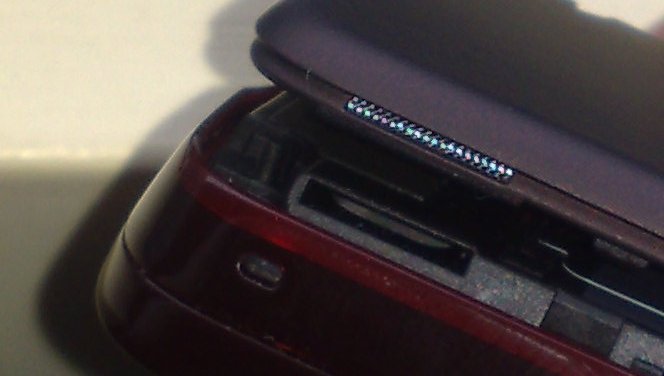
(with cover popped off slightly so that you can see grille and speaker aperture)
I liked the camera shutter key, which is nicely positive, I liked the tethered microUSB port cover and I loved the keyguard toggle. This makes for a supremely quick and handy way of turning the screen off and locking the device in a fraction of a second. And unlocking it again later.

Display
The 5800's display is perfectly sized (for the form factor), is bright (even outside in sunshine, it fares better than resistive touch screens of yesteryear) and fairly responsive. We're not talking iPhone visibility and response here, but it does the job pretty well. One of the pillars behind the iPhone's conception (and, to be fair, behind full screen PDAs since about the year 2000, including, notably Nokia's own 7710, several years before the iPhone) was the idea that very little frontal real estate was used for buttons that got in the way, i.e. the screen itself could adapt, to show graphics or maps or a full qwerty keyboard, as needed at any one moment. The 5800 means that Nokia are now in the same field with a current, fairly future-proof phone - and, to be honest, I've been quite impressed.
One downside of touch-based phones is that they're soon bedecked with fingerprints and the 5800's no exception here. Having said that, the screen is slightly recessed, as is the camera glass, so at least you don't then pick up every last piece of dust on top of the finger grease when you lay the phone down. Maybe we should all just wash our hands more?(!)
Speed
S60 now scales up or down to suit a variety of screen sizes, of course - I wasn't expecting any difficulties here. The speed of S60 5th Edition, even with 'Theme effects' turned off, isn't great yet - there's a slight lag in everything that happens. From the 50ms or so delay after tapping the screen while the haptic vibration system works, to the second or so while some application screens switch in and out, you wouldn't say that the 5800 is blindingly fast yet. However, it's clear that there is still optimsation to be done and I'd expect speed increases in many areas over the next few firmware versions. And as it stands, the 5800 XpressMusic is fast enough for the man in the street.
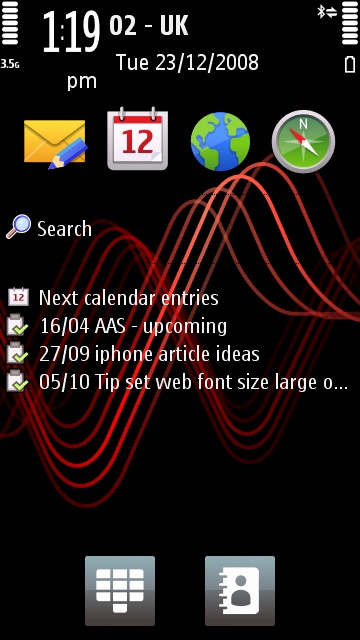
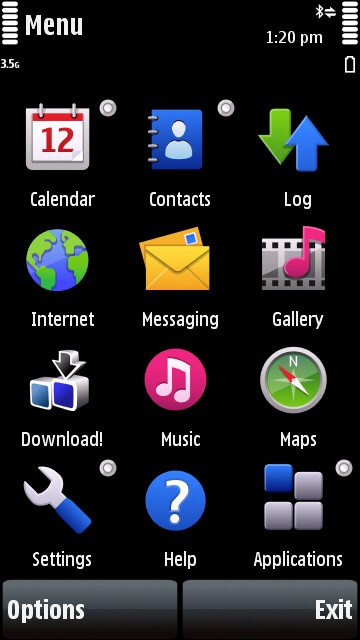
Touch/S60
The most interesting aspect of S60, as implemented here with a touch screen, is the way screen taps are mapped through to each application. I think Nokia have gotten this wrong in several places, with the result that double-taps are needed where single taps would be quicker and less confusing. How I think this should work is that, when faced with a screen of icons or a list of items, a single tap should behave the same as if you'd highlighted the item with a phone d-pad and then pressed in 'Enter'.
For example, in Music Library, you see the usual 'Artists', 'Albums', etc. list. If I tap on 'Albums', I want it to bring up the list of albums, not merely highlight the item, awaiting a second tap. Now, in some very specific places, lists like this have a whole string of context-sensitive options appropriate to each item and in these cases it's probably reasonable to just highlight the item and wait for the user to tap on 'Options', to decide what to do with it, e.g. in File manager or editing Access points. But in well over half the places where S60 5th Edition presents screens full of items, a double tap is needed where it's not really necessary. The end result is that the user taps once and waits. After about a second or so, when it's obvious that nothing's happening, the user sighs and taps again.
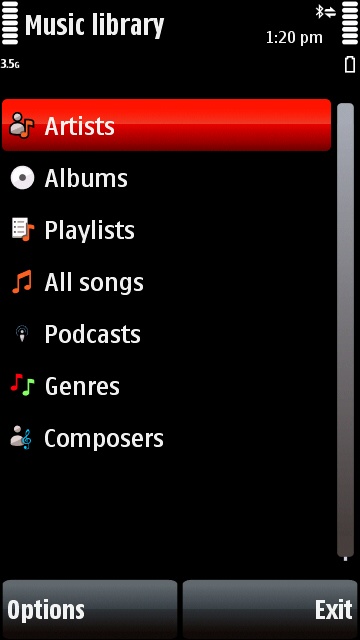
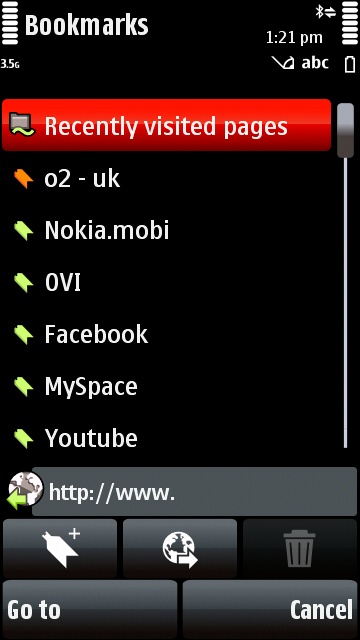
Another example: the list of bookmarks in Web. As a user, you bring up the list and expect to tap on a bookmark to go to that site. After all, what else would you want to do? In fact, there's a small chance that you might want to edit the bookmark or move it around - but this would be better handled by an 'Options' Bookmark editor function. S60's UI designers are rather caught between a rock and a hard place here - they want to keep as much of existing S60 in place as possible, yet also to embrace a new way of doing things. Something's got to give, in the interests of keeping things intuitive.
I accept the fact that there will be some inconsistency in the interface - after all, this is bolting on a whole new means of interaction onto an interface designed for one thumb. But the current situation frustrates as often as it delights.
Text entry
In most cases in the 5800 XpressMusic, tapping on a text field (in order to add or edit text) will pop up your default keyboard, i.e. the one you chose to use last. This is mostly true, though there are a few apps which insist on just the simplified alphanumeric keypad. See Rafe's preview articles (links at top) for more on the text input options. The one that interested me though was the 'Full Screen QWERTY' keyboard - even the Apple iPhone can't currently put up a wide-screen keyboard in landscape mode.
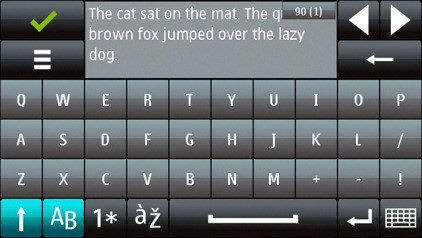
The keyboard layout itself (barely smaller than that on the huge E90) key highlighting mechanism and haptic (vibration) feedback all work rather well, your fingers will soon be trying to fly across the virtual keys. But there's a problem, in that, due to physical restrictions in the resistive touch screen, key presses have to entered below a certain minimum speed, i.e. go too fast and your keystrokes get missed. This is a shame, since I for one had harboured dreams of mastering the layout and letting my fingers work up a decent speed. Yet the faster you get the more keys are missed.
If you have access to a 5800 XpressMusic you can test this yourself. Press a virtual key and then press another while keeping the first one pressed. The second one is the only character registered, even though the screen knows where you first made contact. I'm hoping, really, really hoping that some clever screen drivers can help out to interpret the pattern of a user's taps here, to increase typing speeds for everybody.
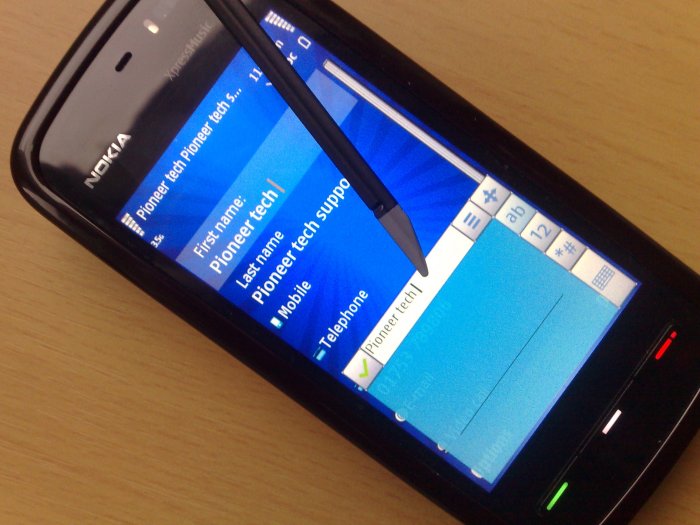
Web
S60 Web hasn't changed much under the hood from the familiar beast on older, non-5th Edition S60 devices, although there have been some optimisations that help it turn in a faster performance, subjectively perhaps 30% faster on some byte-rich pages. The biggest change is of course in the user interface, with the old d-pad-driven, Options-led system now changed to a touch-driven, largely-toolbar-led system. The end result is something that's more functional than it is beautiful, with some functions on the pop-up tools panel, some on the traditional Options menu, and some on both.
Pages can sometimes only be dragged around with a finger once they've been fully rendered, depending on the mix of graphics and Flash objects. This latter restriction does causes problems sometimes. Once rendered, dragging the web image around isn't as smooth as on the capacitively-screened iPhone, but it's not a million miles off. There's no multi-touch here, of course, so zooming is done by double-tapping to cycle between appropriate zoom levels or by using the on-screen zoom control. I found that I was continually using the tool panel 'Full screen' function, in order to be able to see more of my page - a single tap shortcut to this function would have been handy. In landscape mode, particularly, a lot of the screen is taken up by the title bar and toolbar, rather foiling the point in having such a large screen in the first place.
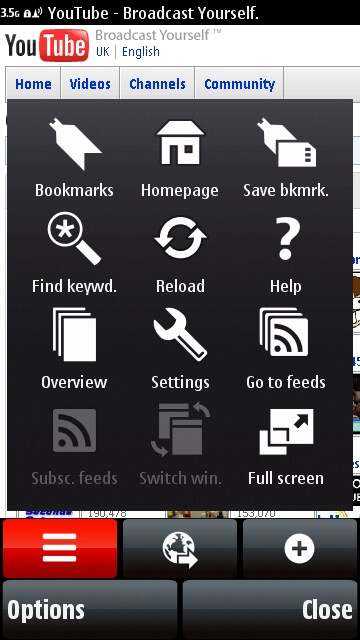
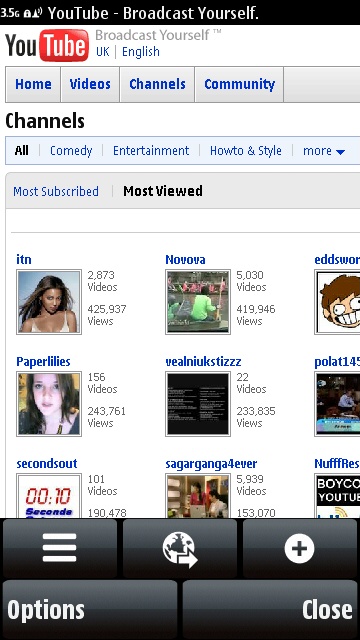
As demoed in The Phones Show 72, watching Flash video 'inline' in web pages is slightly quicker and more streamlined than doing the same on older S60 devices - maybe the Flash Lite code got itself an overhaul? I was initially bemoaning the fact that YouTube clients like Mobitubia and emTube don't work on the 5800 XpressMusic (yet), but in fact it's not that painful looking for videos and watching via the full YouTube site - just steer clear of the incredibly-Flash-heavy front page if possible.
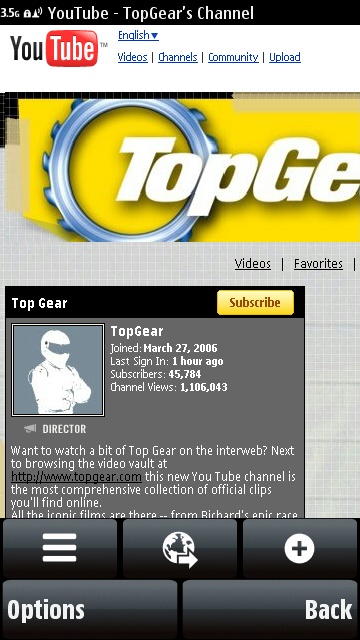
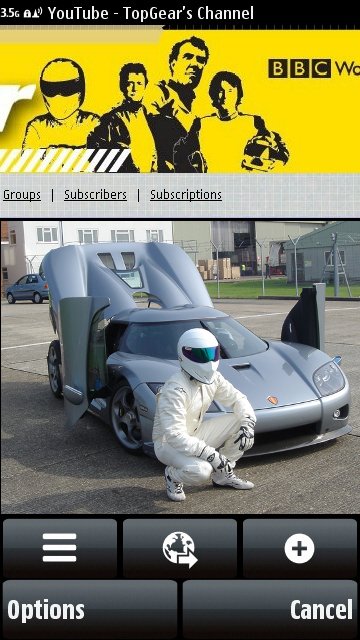
Camera/Multimedia
In good lighting, the 5800's stills and video cameras are up with the very best of Nokia's Nseries phones - the use of Carl Zeiss optics mean that things are kept crisp. However, the internal CMOS sensor is obviously quite a bit smaller, since low light photos have an order of magnitude more digital noise than the equivalents on flagships like the N95 and N96. The 5800 counters slightly, with dual LED flash keeping light levels up in dark situations and by being able to shine out the LEDs when doing video recordings, but there's no substitute for more sensor pixels at the end of the day. Anything taken indoors will end up a disappointment.
Camera samples, click each to download or bring up in your browser:
The exposed camera glass also rather collects fingerprints, given that this is a touch screen phone and fingers will need to brace (on the underside) against finger taps on the front of the device - so you'll need to wipe the camera glass before any important shots!
Still, for a lower priced phone with so many other unique selling points, the camera will please many, especially if used outdoors in daylight. As demonstrated recently, there's one novelty here in that one of the video capture resolution options is wide-screen, effectively created by cropping the middle 640 by 352 pixel slice from the larger VGA video frame in its highest quality mode.
As with stills, it's vital to emphasise that the smaller and cheaper sensor means lots of digital noise when taking videos indoors, dramatically more than on the N82 and N95, for example.

As with most recent S60 phones, Nokia hasn't been able to resist putting in a 'multimedia' key. This time in yet another different format, dropping down from the top-right of the interface at any point and simply offering shortcuts to Music player, Gallery, Share online, Video centre and Web. As usual, the multimedia menu doesn't offer anything new and only really serves to confuse people. In my opinion - hey, maybe new users will love it.....
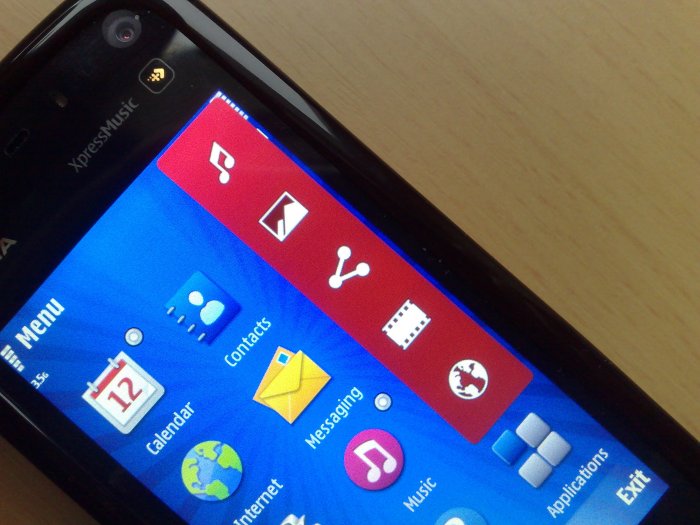
I had no problems whatsoever with video playback, with even raw FLV (Flash video) files being played back well at full-screen size, it seems that despite the lack of video hardware, enough has been optimised in software to fill in as needed. Photo browsing was on the slow side, with only one image 'either side' of the current one being cached - it's quite easy to get ahead of the display software and end up seeing several circular 'loading' icons. In addition, even bringing a photo up for editing results in a wait of up to ten seconds - surely this will be sorted out in future firmware.
Music playback was superb, both in terms of quality, library speed and stereo speaker volume. This last is just extraordinary - the 5800 XpressMusic has the loudest speakers of any phone that I've ever tried. And there are the usual Nokia extras, such as stereo Bluetooth support (A2DP) and also TV out, for playing back music via a Hi-Fi or video/photos via a TV.
Mapping and Navigation
I ran Maps 2.0 on the 5800 over the course of a day's car navigation and had no problems whatsoever - Maps 2.0 arguably works better here than on any previous S60 device. There's the larger screen for clearer maps, plus the touch screen interaction, bringing to mind PNDs like the TomTom GO. And all on your phone, etc. The loud speakers (sic) also helped here, for spoken directions.
Gaming
It's really way too early to call the 5800 XpressMusic a success in respect of games. The device comes with a version of Global Race, an arcade driving game that unfortunately suffers from lack of hardware graphics acceleration (it flies on the N95, E90, etc) and an annoying platform puzzler 'Bounce' (though my daughter enjoyed this!). More than any other application genre, games will need to be rewritten to take into account the new screen size, lack of d-pad and touch-screen layer. N-Gage-compatibility is promised, so there are games on the way from this direction, at least.
Whether the large screen, combined with lack of graphics oomph, will be a problem remains to be seen. At worst case, it might just mean an absence of 3D/sports games. At best, the extra flexibility of having a touch screen will make new genres a possibility for the first time under S60.
Services and third party applications
In recent times, I've had cause to talk quite a bit about Samsung's latest S60 smartphones, in the context of their firmware taking a while to be finalised, but also focussing on support for such newcomers from software developers and service providers. Having a top end phone or smartphone is about much more than just the features you get out of the box.
Such is the case with the Nokia 5800 XpressMusic, with many of Nokia's own services and addons still not recognising the 5800, even after it's been out on the streets in some parts of the world for almost a month. Mind you, I'd expect the pace of compatibility with the rest of the world to be much faster than with the slightly more 'niche' Samsungs - this is the mighty Nokia, after all, with huge resources being thrown at their new device and platform (S60 5th Edition) from all directions, plus the popularity of the 5800 XpressMusic is more or less guaranteed, ensuring a constant stream of attention from developers.
Rafe has already talked a lot about backwards compatibility for S60 5th Edition and this big touch-screen. Among applications that I was particularly interested in, Google's Java Gmail client installed but was very clunky to use - it's based around the assumption that a d-pad is present and on the 5800 you have to use the on-screen virtual d-pad. Best ScreenSnap worked brilliantly for capturing the images in this review, Google Maps 2.3 worked brilliantly as well, with Street View looking great in landscape mode and controllable using touch - on S60, a real novelty. Quickoffice is in the 5800's Download! Catalog (as opposed to being in ROM), which is fair enough for the target market - this also seemed to work well, although I didn't upgrade it to 'editing' status.
Verdict
The hardware team have done a cracking job on the 5800 XpressMusic, it looks and feels like a high quality product. It even feels sexier than the Apple iPhone, although it can't match the latter's speed, graphical prowess or breadth of applications. But then it is a lot cheaper, both SIM-free and on contract. And, in its own way, has some very appealing features: the genuinely phone-width form factor, the widescreen video recording, the application of touch to Web, Nokia Maps and Google Maps, the reasonable quality stills camera (light permitting), the terrific music playback and loud output. Plus the usual Nokia telephony and connectivity strengths.
Bottom line: if I was handed a 5800 XpressMusic, an Apple iPhone 3G and a HTC Touch HD, and was asked to pick one, all costs covered, I would probably still pick the 5800, even though it's by far the cheapest [though I'd take an N95 8GB over all of these without a second thought, if I'm honest]. The 5800 XpressMusic is already a competent contender in the phone world - with some TLC (Tender Loving Care) from Nokia's firmware department over the next few months, it should rise to become a mid-tier flagship.
Steve Litchfield, All About Symbian, 23 Dec 2008
PS. And, of course, the entire 5800 software development experience is paving the way very nicely for the N97, which should arrive with significant polish and a turn of speed, thanks to six months of firmware iterations on the 5800 XpressMusic...

Reviewed by Steve Litchfield at






